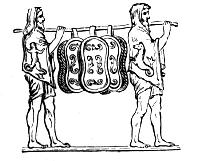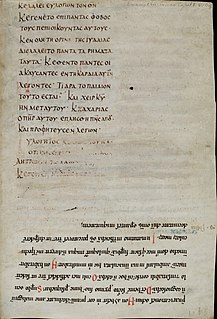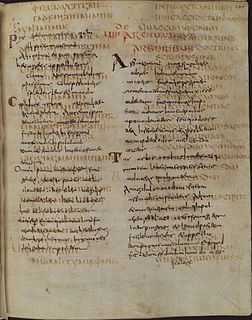
In textual studies, a palimpsest is a manuscript page, either from a scroll or a book, from which the text has been scraped or washed off so that the page can be reused for another document. Parchment was made of lamb, calf, or kid skin and was expensive and not readily available, so, in the interest of economy, a page was often re-used by scraping off the previous writing. In colloquial usage, the term palimpsest is also used in architecture, archaeology and geomorphology to denote an object made or worked upon for one purpose and later reused for another; for example, a monumental brass the reverse blank side of which has been re-engraved.

The Carmen Saliare is a fragment of archaic Latin, which played a part in the rituals performed by the Salii of Ancient Rome. There are 35 extant fragments of the Carmen Saliare, which can be read in Morel's FPL.

The Apostolic Canons, also called Apostolic canons, Ecclesiastical Canons of the Same Holy Apostles, or Canons of the Holy Apostles, is a 4th-century Syrian Christian text. It is an Ancient Church Order, a collection of ancient ecclesiastical canons concerning the government and discipline of the Early Christian Church, allegedly written by the Apostles. This text is an appendix to the eight book of the Apostolic Constitutions. Like the other Ancient Church Orders, the Apostolic Canons uses a pseudepigraphic form.
The Apostolic Constitutions or Constitutions of the Holy Apostles is a Christian collection divided into eight books which is classified among the Church Orders, a genre of early Christian literature, that offered authoritative pseudo-apostolic prescriptions on moral conduct, liturgy and Church organization. The work can be dated from 375 to 380 AD. The provenance is usually regarded as Syria, probably Antioch. The author is unknown, although since James Ussher it has often considered to be the author of the letters of Pseudo-Ignatius, perhaps the 4th-century Eunomian bishop Julian of Cilicia.
The Apostolic Tradition is an early Christian treatise which belongs to the genre of the ancient Church Orders. It has been described to be of "incomparable importance as a source of information about church life and liturgy in the third century".
The Apostolic Church-Ordinance is an Oriental Orthodox Christian treatise which belongs to genre of the Church Orders. The work can be dated at the end of 3rd century CE. The provenience is usually regarded as Egypt, or perhaps Syria. The author is unknown.
Didascalia Apostolorum, or just Didascalia, is a Christian legal treatise which belongs to the genre of the Church Orders. It presents itself as being written by the Twelve Apostles at the time of the Council of Jerusalem; however, scholars agree that it was actually a composition of the 3rd century, perhaps around 230 AD.
Collections of ancient canons contain collected bodies of canon law that originated in various documents, such as papal and synodal decisions, and that can be designated by the generic term of canons.
Cresconius Africanus (Crisconius) was a Latin canon lawyer, of uncertain date and place. He flourished, probably, in the latter half of the 7th century. He was probably a Christian bishop of the African Church.
Uncial 0120, α 1005 (Soden), is a Greek uncial manuscript of the New Testament, dated palaeographically to the 9th-century. Vaya lokosñ

Uncial 0130, ε 80 (Soden), is a Greek uncial manuscript of the New Testament, dated palaeographically to the 9th-century. Formerly it was labelled by Wc.
Edmund Hauler was an Austrian classical philologist born in Ofen to a Danube Swabian German family. His father, Johann Hauler (1829–1888) was also a classical philologist.

Codex Carolinus is an uncial manuscript of the New Testament on parchment, dated to the 6th or 7th century. It is a palimpsest containing a Latin text written over a Gothic one. The Gothic text is designated by siglum Car, the Latin text is designated by siglum gue or by 79, it represents the Old Latin translation of the New Testament. It is housed in the Herzog August Library in Wolfenbüttel in Lower Saxony, Germany.
The ancient church orders form a genre of early Christian literature, ranging from 1st to 5th century, which has the purpose of offering authoritative "apostolic" prescriptions on matters of moral conduct, liturgy and Church organization. These texts are extremely important in the study of early liturgy and served as the basis for much ancient ecclesiastical legislation.
The Alexandrine Sinodos is a Christian collection of Church Orders. This collection of earlier texts dates from the 4th or 5th century CE. The provenience is Egypt and it was particularly used in the ancient Coptic and Ethiopian Christianity.

The Paenitentiale Theodori is an early medieval penitential handbook based on the judgements of Archbishop Theodore of Canterbury. It exists in multiple versions, the fullest and historically most important of which is the U or Discipulus Umbrensium version, composed (probably) in Northumbria within approximately a decade or two after Theodore's death. Other early though far less popular versions are those known today as the Capitula Dacheriana, the Canones Gregorii, the Canones Basilienses, and the Canones Cottoniani, all of which were compiled before the Paenitentiale Umbrense probably in either Ireland and/or England during or shortly after Theodore's lifetime.

The Collectio canonum Quesnelliana is a vast collection of canonical and doctrinal documents prepared (probably) in Rome sometime between 494 and (probably) 610. It was first identified by Pierre Pithou and first edited by Pasquier Quesnel in 1675, whence it takes its modern name. The standard edition used today is that prepared by Girolamo and Pietro Ballerini in 1757.

The Collectiones canonum Dionysianae, also known as Collectio Dionysiana or Dionysiana Collectio, are the several collections of ancient canons prepared by a Scythian monk, Dionysius 'the humble' (exiguus). They include the Collectio conciliorum Dionysiana I, the Collectio conciliorum Dionysiana II, and the Collectio decretalium Dionysiana. They are of the utmost importance for the development of the canon law tradition in the West.
The Fragmenta Vaticana are the fragments of an anonymous Latin work on Roman law written in the 4th century AD. Their importance to scholars stems from their being untouched by the Justinianic reforms of the 6th century.